
Original Link: https://www.anandtech.com/show/817
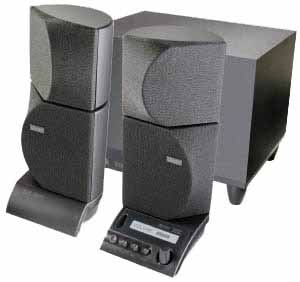
Altec's most recent offering in its line of stackable surround solutions is the ADA890. Like its predecessors, it comes with rear surround speakers that can either be placed in dedicated cradles behind the listener, or the rear sats can be stacked on top of the front pedestals, allowing the system to offer both 4.1 and 2.1 format options.
The ADA890 also carries the THX multimedia certification seen in a predecessor unit, the ADA885. Though many write this certification off to marketing hype, it is important to consider that it does come from somewhere. At the least, there are some documented technical standards behind the name, which carry over between manufacturers that have achieved this certification. More can be learned about the standard from the THX webstie, www.thx.com.
The unit consists of a subwoofer, two front satellites on integrated pedestals, and then two rear satellites on detachable cradles. The front right pedestal contains the control module for the system; this can not be moved to the other side. For inputs, the system offers four channels of analog input (front and rear stereo), and a coaxial digital input. For optical digital sources, Altec offers the OC1 adaptor to convert to a coaxial input.
Here's what Altec says about their system. In addition to the standard specifications, there's some extra information here provided by Altec to help our readers make an informed decision, in bold:
| System Response |
27Hz - 20kHz, -10dB; 50Hz-16kHz +/-2dB |
| Total Audio Output |
120 Watts RMS(103 dB SPL@ Listening Position) |
| Total Impedance |
>10k Ohms |
| Analog Input Sensitivity |
300 mV for full output |
| Digital Input | S/PDIF* |
| SATELLITE SPEAKERS | |
| Drivers |
Drivers
Four 3" Full Range |
| Two 1" Tweaters |
|
| Power |
60 Watts (15 watts per satellite) at 0.3%THD |
| Signal-to-noise Ratio |
>70dB |
| SUBWOOFER | |
| Driver |
One
8" dual voice coil |
| Power |
60
Watts at 10%THD |
| Crossover Frequency |
150Hz |
| Signal-to-noise
Ratio |
>70dB |
| POWER REQUIREMENTS | |
| USA/Canada |
120v/60Hz/360W |
| Europe/UK/various Asian
Countires |
230v/50Hz |
| UL/cUL/CE Approved | |
| DIMENSIONS | |
| Subwoofer | |
| Main Speaker |
137mm Wide x 110mm Deep x 162mm High |
| Surrounds | 110mm Wide x 104mm Deep x 117 mm High |
| * Sony/Philips Digital Interconnect Format | |
Setup
Out of the box comes an assortment of parts and cables. The subwoofer/amplifier enclosure dominates the package, though the remainder of the space is carefully packed with the front and rear satellites enclosures, stands, and cabling. Also included is a detailed drawing for connection options. The first step in assembly is deciding the desired setup format.
The first decision comes in the physical setup of the unit. The rear satellites
come from the factory installed on their own stands for placement behind the
listening position. Another installation option is to mount them on top of the
front satellite speakers. In this position, the speakers are aimed off axis
to help create the surround effects the "rear" speakers will be reproducing.
 |
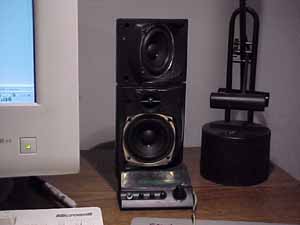 |
Installing the rear speakers on top of the front satellites is fairly straightforward. A simple rotation and lift is enough to remove them from their factory stands. On top of the front satellites, there is a rubber plug that must be removed. Once the plug is out, the rear speakers are placed in the fronts and rotated again to lock them in place. The connection is keyed to ensure alignment and proper placement. Lining up the curved edges of the speaker grills to create a compound curve is also a way to ensure the alignment.
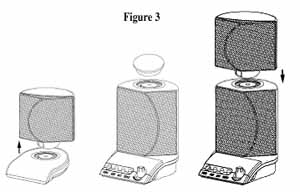
When using the rear speakers in the 4.1 mode in which they are placed behind the listener, in their detachable cradles. The cabling included with the system is sufficient to reach around a small room for placement behind the listening position. As with the other connections in the system, the connectors are both color coded and keyed for proper connection.

Once the surround speakers have either been docked or laid out behind the listening position, placement of the front pedestals and subwoofer remain. The front speakers follow a normal stereo layout; make an isosceles triangle with the listener at the vertex. Altec recommends as much separation of the speakers as possible to obtain the best stereo image. Note that that the satellites are not interchangeable - the pedestal with the control pod belongs on the right hand side of the system, while the left pedestal contains the headphone jack.
The subwoofer tucks away under the desktop. Experiment with positioning the unit under the desk once the system is powered up, as physical location can affect its acoustics and how it interacts with the "bass trap" of space under the desk. As the enclosure is where all of the system connections terminate, it is beneficial to get the sub close to where it goes, but wait on final placement until all connections have been made.
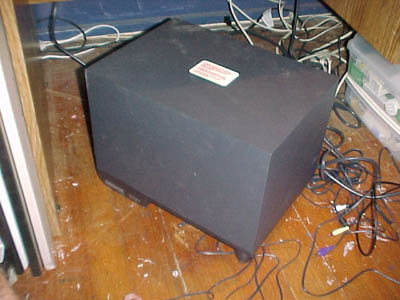
The format decision is somewhat going to dictate the layout and cabling of the system. The signal for the surround speakers is routed by the system to whichever stand they are sitting in. For rear placement, there is a separate minijack connection for each side that must be run back to appropriately colored connector on the subwoofer. The coloring differentiates between left and right; the units are symmetric, not interchangeable. When in the front "three speaker" configuration, the signal feed is provided through the cabling that connects the front pedestals to the system.
More Setup
Once the connections within the speaker system have been made, it is time to interface the system to the source. Included with the system are a variety of adaptors, cables, and diagrams designed to make the process easier. There are a couple of ways to connect the system to a standard computer system sound card that encompasses both digital and analog connections.
For four channel gaming, where the sound processing is done in the soundcard and software, the output takes the form of two stereo audio streams. One serves the front two speakers, and the other stereo stream is for the rear satellites. To accommodate this format, Altec includes a four channel analog input to the system. The connection is via two minijack cables, colored to match the connections on most soundcards. The green channel is for the front channels, and the black connection is for the rear channels.
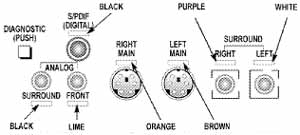
When using the system with a card that only supplies two channel output, only the front minijack cable would be used. This connection format will prevent the "Quad" speaker mode from operating fully as it uses the rear channel stereo feed for the rear satellites. Otherwise, in stereo mode or ProLogic mode, the system will operate normally.
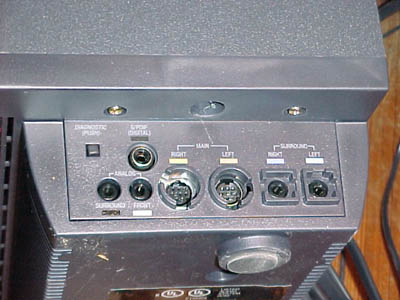
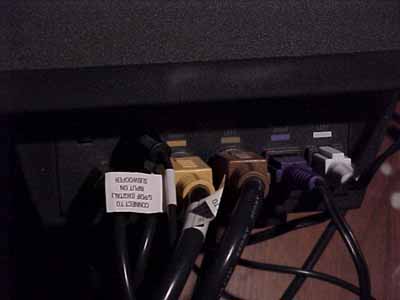
A digital connection is provided to the system via a coaxial S/PDIF connection. For many soundcard users, this connection is provided via a minijack connection on the soundcard, usually a yellow or orange colored connection. Included with Altec's system is an adaptor dongle that will adapt from the minijack to an RCA connection, which can then be run to the system with the included RCA cable.
For sources whose digital output is in the form of a TOSLINK connection (optical digital output), Altec offers an adaptor (model number OC1) to convert from the optical signal to coaxial. This device connects to the optical source, the coaxial input, and also inline with the connection to the right main channel. The adaptor will also convert the AC-3 data from coaxial to optical, so it will preserve surround sound information.
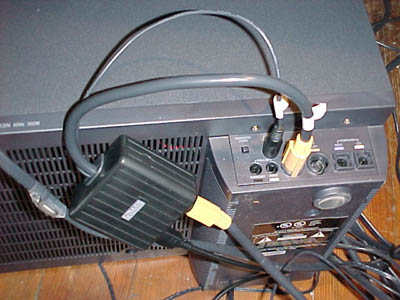
Once the connections are made to the source, the main power can be connected and the system may be energized. Once the power is connected, the system goes in to standby mode. An LED on the front of the subwoofer will glow green when the power conditions are within a safe operating range. The system can be powered up by pressing the power button on the right front satellite.
Listening Modes - How they sound, 2.1 configuration
2.1 configuration
The ADA890 system has a number of sound configurations that are selectable at
the right front satellite pedestal. The mode button cycles through the various
modes in the following order: Stereo, StereoX2, ProLogic, Quad, and Dolby Digital.
Depending on the input configuration, some options are not available or operate
slightly differently than the description; these differences are described with
the relevant connection configurations in the setup section.
For those users choosing to set up the system with the rear satellites stacked on top of the fronts, the system falls into a 2.1 configuration. However, the "rear" satellites are still independent, and angled away from the user to simulate a surround field. This system works pretty well.
In stereo mode, the main front satellites operate along with the subwoofer to reinforce the bass of the system. This mode works for both the digital input as well as the analog input; in each case it uses the front stereo information provided. The coverage is comparable to a near field stereo setup; there is good separation at the listening position between channels. For stereo music playback, it is the most straightforward option.
The analog input, when routed to stereo input, has a warm tone that has strong fill through the midrange section. The analog input also carries a denser bass response that will provide more thump and power. The highs, provided from a separate driver in the front satellites, are well balanced with the rest of the frequency spectrum. The bass response to the bass adjustment is strong; it is responsive to adjustments both in the highs and lows.
The digital input provides a somewhat cleaner sound, with different emphasis in the spectrum. The bass is clean and defined, though has less strength in the digital mode than in analog mode. The highs carry more presence in proportion to the bass as a result, moving the sound more out front. Dialing the highs back a bit, and the bass up provides a mellow sound that fits the input well.
StereoX2 moves the front input information to both the front and rear satellites. As the rear satellites do not have the independent tweeter, this changes the sound characteristics somewhat. The lower highs take control of the sound, with less bass presence to keep up. This is especially the case in the 2.1 mode setup as the sonic source for mids essentially doubles, plus the rear satellites are trying to handle frequencies that would be better suited by a tweeter.
The sonic effect is a thicker sound, with less separation between channels. The mids and highs are more emphasized, and less responsive to the tone controls. The coverage of the system is larger due to the angling of the rear satellites, so the soundfield is larger. In the analog mode, the added midrange takes what was previously warmth in the sound and overemphasizes it. Switching to digital mode, the added midrange fills in some of the accuracy to make the sound smoother. In both input modes, the bass needs to be dialed up some.
![]()
ProLogic mode is the next option. This selection processes the input to send certain parts of the sound stream to the rear satellites and other parts to the center channel, were it present. In this case, it serves to add the midrange frequencies to the rear sats to create a more immersive soundfield. The limited frequency range helps limit the wall of sound effect seen in the StereoX2 mode, as the rear sats aren't handling high frequencies their drivers aren't designed for.
ProLogic mode is only offered for the analog input section, and will be silent in digital only mode. The combination of analog mode and ProLogic makes for an enhanced listening mode for stereo audio. It isn't the pure stereo mix, but it is an enjoyable listening environment. It's also useful for getting surround sound out of now Dolby Digital encoded sources.
![]()
Dolby Digital mode serves a couple of roles, depending on which input is routed to it. With the analog input, it acts just like Stereo mode. It performs this same function if the digital input is not encoded with AC-3 data. Remember that the rear satellites are inactive in this mode if the input is not encoded with surround data. When AC-3 data is present, the mix is decoded and reproduced through the appropriate drivers. As there is no center speaker in the system, the center channel is downmixed to the front main speakers. In the 2.1 mode, the surround speakers shoot off to the side. For a single listener, this can somewhat approximate a surround field, though is less effective than running the system in 4.1 mode.
Quad mode is available when four channels of analog information are connected. In digital input mode, the system will only operate in normal stereo mode. In analog quad mode, it reproduces the front two channels to the front surrounds, and the rear channels to the rear satellites, as would follow naturally.
Unfortunately, there is a technical problem with quad mode. According to Altec, the system originally was designed as an OEM solution to accompany a Dell computer. The original configuration included a four channel sound card in which the rear channels were wired out of phase with the front channels. To correct for this in the original system, Altec wired the rear input out of phase with the front channels. This same architecture is included in the current system.
However, most current four channel sound cards are wired in phase. This causes phase cancellation in quad mode, especially in the subwoofer. The low frequencies from both the front and rear are routed to the sub for reproduction. They are 180 degrees out of phase, and cancel each other out completely, resulting in little to know bass in many situations. The result is unacceptable sound when in quad mode.
Listening Modes - How they sound, 4.1 configuration
4.1 Configuration
Setting the system up with the rear surrounds on their stands, located behind
the listening position, creates the 4.1 configuration. This changes the sound
field for the following modes-StereoX2, Quad, ProLogic, and Dolby Digital. For
the other modes, the sound field is the same, as they only used the front satellite
pedestals for playback. This includes Dolby Digital mode when fed any analog
feed or digital data lacking AC-3 encoding.
Moving the satellites back adds some cabling, but improves the surround sound in the system immensely. As the rear information is actually reproduced behind the listener, the sonic source is a positive step for directionality. Here's how it breaks down specifically to each mode:
StereoX2 in quad mode improves the response over what was seen in the 2.1 mode. Instead of a wall of sound effect where two drivers stacked on each side shot the same thing, the sound now comes from multiple directions. This makes for a more uniform, but sonically thick, listening environment. Also, the concept of a stereo sweet spot is no longer just between left and right; now, there is a forward position at which there is a balance between front and rear satellites that is desirable. For individual users, this creates a more immersive experience, though some directionality is lost as the sound comes from twice as many sources.
![]()
ProLogic mode in 4.1 allows the system to live up to the original design of the decoding format. Specifically, only a limited bandwidth of effects surround sound is sent to the rears. As the driver format is different in the rear (no tweeter for high end reproduction), the rear satellites are well suited to the limited bandwidth reproduction. The rear positioning makes more sense as the surround effects are not washed over by the front channels. Stacking with an offset angle makes for a cleaner setup, but not necessarily better.
Quad mode is again plagued by phase cancellation in the bass unit. Effectively, this renders the mode unusable since there is no bass for gaming, which is usually the true appeal of the quad mode. Also, it prevents any software based decoding of surround sound. Altec is addressing the problem, but until it is solved, this mode is unusable.
![]()
Dolby Digital mode is an opportunity for the system to apply its low noise floor and clean digital input to movie quality sound. The performance of the system in this mode is definitely commendable. Though the headroom for a quieter digital signal is somewhat lacking, there is excellent tonal quality at a moderate level. The system has a low noise floor that improves the overall clarity. The bass is less dense than some of the analog modes, but again very clean. This makes for an accurate sound field.
Conclusion
Altec's most recent offering in its desktop surround sound line continues on a strong tradition of sonic quality in the past. The acoustical approach to the system provides a basis on which a variety of features build to create the finished product. For some applications, the system works extremely well together, while in others, it falls decidedly short due to some technical issues.
In the 2.1 setup mode, where the rear satellites are stacked on top of the front pedestals and angled outward, the system offers a compact approach to surround sound environments. In near field listening environments, the system is able to simulate a surround sound field. However, it is somewhat limited to the number of users or scaling; its approach is based on a very nearfield environment.
This same 2.1 mode works extremely well for stereo music playback. For users who find this as a primary use, taking advantage of the warm analog inputs with more headroom while still having a small surround sound system to fall back on is a nice combination.
When spreading the system out to 4.1 mode, the quality of the surround sound field and overall listening experience is increased. The improved separation of audio sources widens the sound field. More people could enjoy the program material accurately in this mode.
One major drawback to the system is the malfunctioning Quad mode. For gamers, this would be the primary listening mode; it allows for four channel soundcards to create an audio environment to accompany a gaming experience. However, the phase cancellation in the system renders this input unusable.
Besides the problems with quad mode, the system is fairly responsive sonically. Its treble and bass adjustment points are well suited to fit the system, and allow for the sound to be tweaked as needed. Overall, the analog inputs are warmer than the digital ones, though they add presence to the low midrange in the sound. The digital input is very clean and consistent, though the headroom seems a little low.
The system sets up incredibly easily. Everything is color coded, and the full page, full color diagrams present multiple configuration options. For listeners that don't have a front mounted headphone jack, there is one provided on the front left pedestal.
Overall, if the quad input worked properly, the system would be an excellent package. The MSRP is $349, though it can easily be found online for $250. Still, this money is spread across a package trying to do multiple tasks while still completely failing at one. Keep an eye out for a fix from Altec, and then it will be a valuable package. For pure music listening and surround sound playback, the system still stands as a competent package, though with a decent price tag. However, the sonic quality of the system is somewhat higher than other comparably priced systems; though THX multimedia certification is a marketing technique, it is based in some real quality standards, and the system did acquire it.







